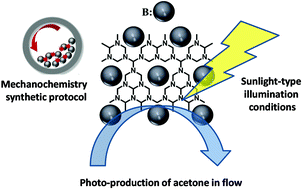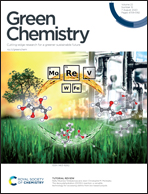Facile synthesis of B/g-C3N4 composite materials for the continuous-flow selective photo-production of acetone†
Abstract
In this work versatile boron–carbon nitride composite materials were synthesized and utilized in a sustainable process using sunlight as the energy source for the continuous-flow selective photocatalytic production of acetone from 2-propanol. It is worth highlighting that the sample preparation was carried out by an environmentally friendly strategy, without a solvent or additional reagents. Samples containing boron in 1–10 wt% were subjected to physico-chemical characterization using XRD, porosimetry, UV-visible spectroscopy, TEM, energy-dispersive X-ray spectroscopy and XPS. The reaction output was analyzed on the basis of the reaction rate, selectivity and quantum efficiency of the process. A correlation analysis between catalytic properties with two observables, the boron phase distribution in the materials and charge handling efficiency (measured using photoluminescence), rationalizes photoactivity. Such an analysis indicates that the presence of an amorphous boron metallic phase and its contact with the carbon nitride component are key to setting up a renewable and easily scalable chemical process to obtain acetone.



 Please wait while we load your content...
Please wait while we load your content...